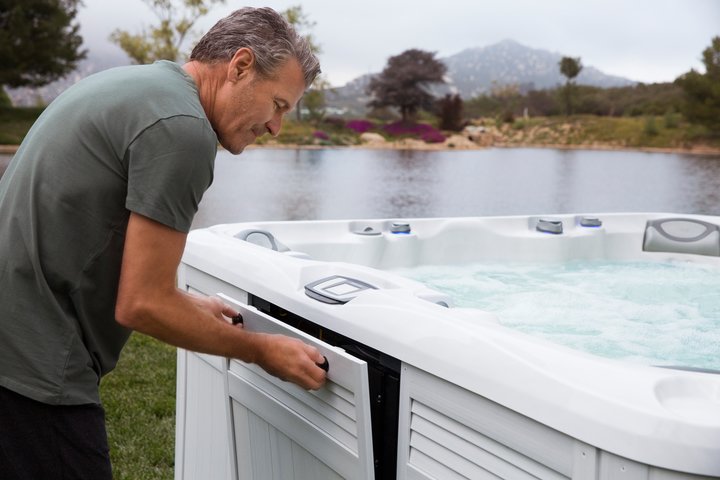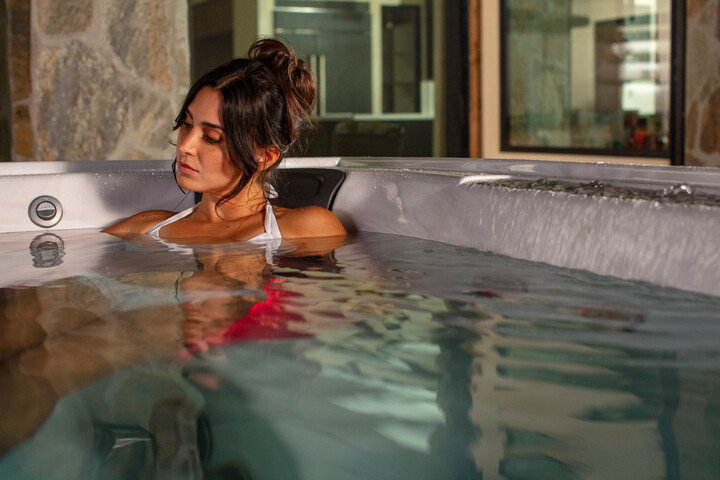Hot tubs create luxurious ways to relax in your backyard and provide a great entertainment space all year round.
If you like to enjoy a gentle massage from the jets each night, it’s likely you’re well aware of your water’s natural state when it’s healthy. This can be a useful bit of knowledge if your water suddenly turns.
Issues happen even in the best of spas and knowing the hot tub repairs needed for each one is essential in easily maintaining your spa throughout its lifetime.
Often, issues first show up in your water. If left untreated, they can wreak havoc on your entire system. This can result in more costly repairs in the future if parts of your system are subject to poorly balanced or untreated water too often.
If you want to maintain your crystal clear water and make managing your hot tub easy, you’ll want to be aware of these four common problems and the hot tub repairs that can fix them before they become bigger issues.
4 Common Hot Tub Problems and How To Repair Them
Knowing when your hot tub is crying out for help is essential in maintaining its health long-term. Your water is often the first thing to notify you of any issues with your system, so it’s important to check the water before jumping in.
The water in your hot tub is sensitive and can quickly deteriorate when it experiences harmful conditions, such as being exposed to rain or snow or being overused by too many people during a fun hot tub party.
If you’ve discovered any of these common issues with your hot tub, it’s likely your water needs some care. These are the most common hot tub issues, and exactly how you can repair them when they arise.
1. Cold Water
No one wants to lift up their hot tub cover and dip their fingers into the water only to discover it’s cold!
If you’ve experienced a sudden drop in water temperature, your hot tub’s heater is likely beginning to fail.
Your heating element is constantly exposed to water, and over time, this can cause it to corrode. This significantly reduces the effectiveness of your heater, often leading to cold water in your spa.
While a damaged heating element is the most common reason for cold water, it’s not the only one. Some other common causes of cold water include:
- An airlock in your system
- Debris buildup or clogs in your circulation system
- Dirty Filters
When you first discover cold water, it’s important to rule out all potential causes, starting with the heating element. If your element shows signs of wear and tear, it’s likely your best bet to replace it.
While it’s best (and easiest) to replace your heater as a whole, if you’re up for the challenge, you can replace just the element. This is a more intensive process and will take some technical knowledge, so if you choose this route, be prepared and do your research!
If your heater seems to be in good working order, you should do a flush of your system to push out any potential air locks that may have developed. These airlocks are normally diagnosed by checking your jet pressure.
If your jets seem to be pushing out a weak flow of water, an airlock is likely the cause of your chilly water.
Flushing out an airlock is relatively simple. To start, fully open your jets, allowing for maximum water to flow out. Then turn them on to their highest setting for 10-15 seconds at a time. Once you begin seeing bubbles coming out of the jets, leave them running at full power. As they run, they’ll continue pushing out the air until your water is moving through your system at full force again.
If your water still fails to begin warming after you’ve flushed your lines or your jets are already working properly, you should check your filters. If they’ve collected too much debris and haven’t been cleaned, they can block your water from properly flowing through your system.
This can result in dropping water temperatures. If your filters haven’t been cleaned in a while or look discolored when you pull them out, rinse them off with gently running water, then spray them with a filter cleaner to remove the more stubborn build-up on them.
After you’ve let the filter cleaner soak into your filters for 15 minutes, rinse them off, inspect them for damage, and return them to your hot tub.
2. Low Jet Pressure
If you’ve just settled in for a relaxing massage after a long day, you may be disappointed if you turn on your jets and discover they’re pushing out drastically less pressure than usual.
If this happens, it’s usually caused by an airlock in the system, essentially, this happens when air gets into your pipes and blocks the flow of water. If you’ve recently changed your water, this is likely the culprit of your weak jet pressure.
As mentioned above, to flush an airlock out of your system,
- open your jets as far as possible,
- turn your jets on full power for 10-15 seconds at a time,
- Watch for bubbles beginning to come out of your jets,
- set them to full pressure, letting them run until your jets are working at full strength again.
3. Cloudy Water
If you’ve lifted the cover of your hot tub and discovered murky water, your plans for a relaxing soak will need to be put on hold.
This is a surefire sign that your water is out of balance and filled with bacteria. If you use it in this state, you risk exposing yourself to higher rates of bacteria, leading to skin and eye irritation or even infections!
Cloudy water is typically the result of one or more of five issues with your water:
- High pH or alkaline levels
- Dirty filters
- Overused water
- Excessive oil buildup
- Low sanitizer levels
Diagnosing the culprit is often as simple as performing a water test or checking your filter, making it one of the easier issues to manage.
Begin by testing your water and treating it accordingly. If your alkaline and pH levels are too high, you’ll want to use a pH decreaser to bring your water chemistry back into balance.
If your sanitizer levels are low, add the appropriate dose of your sanitizer to bring it back into range. At this time, you can also shock your water with an oxidizing treatment to break up any organic matter that’s built up in the water.
To properly mix your water treatment products into your hot tub, ensure your system is running when you add them. Leave your spa running for at least 15 minutes to effectively treat your water, then turn off your jets and cover your spa to prevent too much evaporation from happening.
After 30 minutes, your water will be ready to retest to verify the levels are back within range.
After you’ve treated your water, remove your filters and rinse them off. If you haven’t performed a deep clean on them in a few weeks, spray them down with filter cleaner and let them rest for 15 minutes to help release any stubborn buildup before rinsing them off and returning them to your spa.
4. Foamy Water
If your water has developed a layer of foam on its surface, you likely have a build-up of organic matter or chemicals in your water.
Each time you enjoy a relaxing soak in your spa, any oils on your body will run off your skin and into the water. These oils are often lotions, deodorants, hair products, cosmetics, perfumes, or even the residue detergent can leave on your swimsuit.
These oils are difficult for your chlorine to break down and aren’t easily filtered out through your filtration system. When too much of it builds up in your water, you’ll often discover foam developing once you turn on your jets.
If your hot tub has foam in it, it’s best to shock it with an oxidizer. Oxidizers are made to break up the organic matter so that your sanitizer can be more effective at cleaning your water. Once added, cycle the treatment throughout your entire hot tub.
If the foam doesn’t seem to clear after treating it with the oxidizer, you’ll need to change your water and clean your hot tub. This will eliminate the contaminants that are causing the foam and leave you with fresh, clear water once again.
Oil buildup can be combated in a number of ways, reducing the chance of foamy surfaces developing. To be proactive about the contaminants entering your water, you can:
- Shower before you soak
- Add tennis balls after your session
- Keep your hair tied back or in a hat
- Add an extra rinse to your wash cycle when cleaning your suits
35 Years of Expert Hot Tub Service in California
Whether you’re in the market for a new hot tub to amplify your backyard this season or are looking for a top-rated hot tub service team, Paradise Valley Spas has everything you need.
With eight locations across California, our team of experts are ready to help. Our showroom is stocked with leading hot tub brands, and we have all the supplies and accessories to make your new spa into your perfect oasis.
If you’re experiencing any of the above issues or are struggling with recurring water issues, our team is happy to help. Explore our hot tub service solutions, and get in touch with us to schedule an appointment to have one of our technicians come inspect your spa.
To explore all our hot tubs, swim spas, and saunas, visit your local showroom today.




